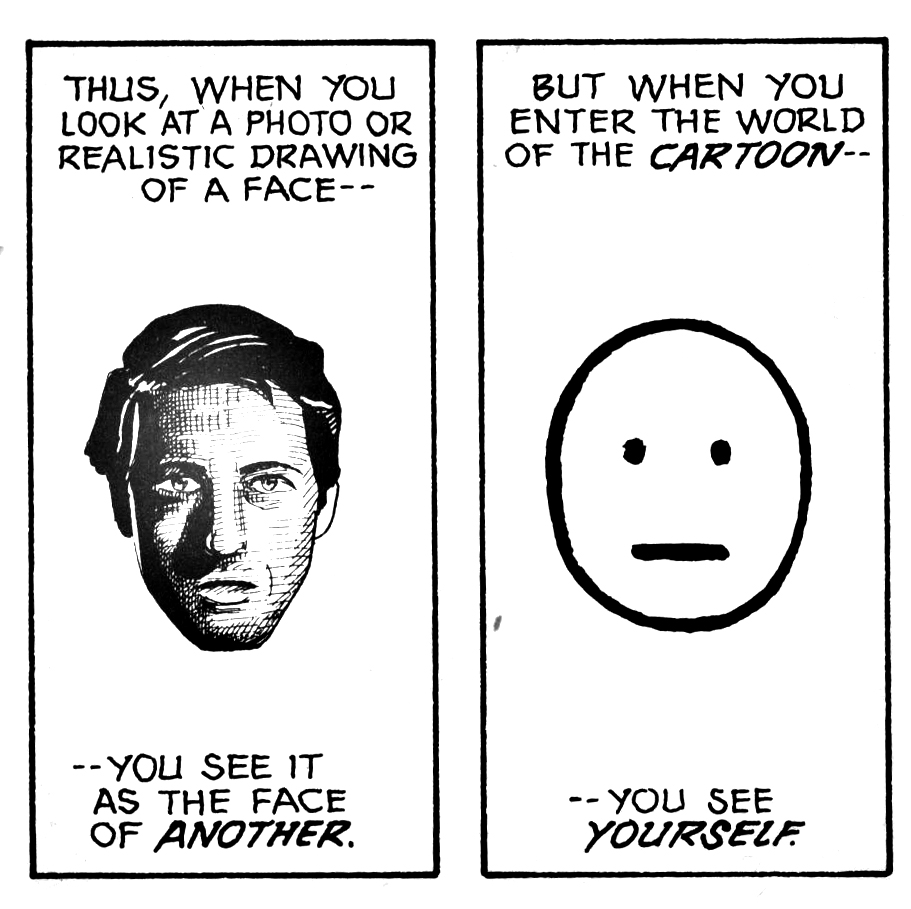Abstraction vs. Realism
(photos coming soon)
<img src=“_photos/abstractrealism.jpg” alt=“Abstract vs Realism” style=“width: 60%;“>
I’ve been thinking a lot about the abstraction versus realism scale. After reading about it in Scott McCLoud’s book Understanding Comics, I see the concept everywhere now, not only in art.
Realism mediums
- Photographs
- Commercial Film
- Naturalistic Sculpture
- Memoirs
- Music with acoustic instruments as they sound in real life
- Maps
- Anatomical Drawings
Abstract mediums
- Comics
- Cartoons
- Poetry
- Free Jazz
- Emojis
- Infographics
- Logos
Realism aims to represent and mimic the real world. Abstract things try to distill, reframe, or symbolize the world.
Realism gives you all the information and detail up front. Abstract things rely on the viewer to fill in the details with their own mind.


Realism vs. Abstract
Realism is loaded with pre-set meaning. When something is realistic, the information is presented directly, leaving little room for imagination. You are saying: This is what it is. This is how you should interpret it. This is what it means.
Abstraction opens space for interpretation. When something is abstracted, the viewer is invited to project their own imagination, ideas, and worldview onto the piece. You are saying: Here is the space to enter. What do you see inside it?
Abstraction: Use Cases
- Focus On The Message: When you just want to deliver a specific message or the “essence” of something and you don’t want the messenger to get in the way / it is not important who the messenger is, it can be helpful to make the messenger abstract. You can remove other details to distract from your core concept.
- Invite Participation: When you want the viewer to actively project their own imagination, emotions, and worldview onto the work, abstraction creates an open space for interpretation.
- Amplify Emotions Beyond: Our inner world and emotions are often much richer and more complex than natural language can describe or realistic images can represent. Abstraction opens the world up to heightened expression — exaggeration, distortion, and symbolism can convey feelings beyond what realism can show.
Realism: Use Cases
- Focus On Accuracy: When you want to show something exactly as it is, with all its details intact, realism is the most effective. Realism is grounded in clarity and leaves little room for ambiguity. The audience sees and understands the concept in the way you intend.
- Build Trust: When credibility matters like in journalism or documentary, realism conveys authority and truthfulness through real representation.
- Anchor in the Familiar: When your work explores new, challenging, or [outside-the-Overton-Window ideas](https://en.wikipedia.org/wiki/Overton_window), using realism can give the viewer something recognizable and more comfortable to hold onto, making the concept more accessible.
Weird Places For Abstract vs. Realism
Quiet & Mysterious Men: There was a guy I used to know who was reserved and did not say much in social settings. From what I heard (we did not go to the same college) he was immensely popular in college among women, despite his “nerdy-ish” appearance! His friends called it “Aaron Factor.” My theory is that since he did not say much, it opened his character up to interpretation. His silence gave people space to project their own ideas of who and what he was like. Is that crazy? Homie was just abstracted.
Kendrick Lamar vs. Young Thug: Kendrick Lamar says listen to what I’m saying, listen carefully to my lyrics and clever wordplay. Young Thug says it’s not important you understand what I’m saying—just feel.
Takeaways
It has been interesting to test and experiment with more abstract elements in video and film.
The Throne: In one unreleased project featuring a man on a toilet. We opted out of having narration to leave it more open to interpretation. I’m treating the concept of this piece as a kind of rorschach test or inkblot test… It is strange, what do you see in it? How do you feel walking away from it?
New Rap: [I recently posted a minute long rap video](https://www.instagram.com/p/DNbcGOZMUuT/). It is abstracted in many ways. The vocals are distorted and mumbled in a way that they are indecipherable. The subtitles are not accurate, in Japanese, and blurred out. It is more about the vibe and feeling than: What is this idiot trying to say?
Previous Dislike of Abstract Things
Some abstract works of fine art require knowledge of art history and general history (an awareness of what was happening when the work was made) in order to appreciate and understand the work.
I used to dislike abstract works because I did not approach it with an open mind, and I did not understand it. It’s easy to like realism art because it can be taken at face value, it’s all presented to you. You can turn your brain off and still enjoy it. Even worlds like Star Wars and the MCU, despite being fantastical, are still rooted in a kind of realism. They still occur in a world that we understand and live in.
I’ve been coming around to being able to appreciate more abstract art. I can still totally understand why abstract art can piss people off. But (1) if you approach it with an open mind, the world of possibility expands tremendously, (2) you will be able to appreciate and feel more stuff in the world, not only art. Also, a lot of art you already enjoy is abstract! Like cartoons and even words. Words are an abstraction, they are squiggles that are supposed to represent the real thing (I think).
Hiding Behind “Oh It’s Abstract”
One of art school’s biggest critiques is probably that student artists have not given the concept of a piece of work any thought, and when pressed about it, lean back on “oh it’s abstract.”
I’m thinking deciding whether to make something more abstract versus realist should depend on the concept and intention behind your piece, duh!


